Journal of
eISSN: 2378-3184


Review Article Volume 13 Issue 2
Centro Interdisciplinario de Ciencias Marinas, Instituto Politécnico Nacional, México
Correspondence: Ernesto A Chávez, Centro Interdisciplinario de Ciencias Marinas, Instituto Politécnico Nacional, México
Received: May 13, 2024 | Published: May 30, 2024
Citation: Chávez EA. Quantitative assessment of the sardine and shrimp fisheries of the Gulf of California. J Aquac Mar Biol. 2024;13(2):48-51. DOI: 10.15406/jamb.2024.13.00396
A brief description of the bio-economic evaluation of the shrimp and sardine fisheries of the Gulf of California is made. These fisheries resources are the most important that are exploited in Mexico. It is considered that the evaluation of fisheries with a quantitative approach is the only option to make precise and informed recommendations for the management and conservation of fishing resources, taking sardine and shrimp fisheries as examples. The Fishing mortality and the age of the first catch are the variables used as a core for simulating the management options, then, yields and profits are the expected outputs of the models to be chosen as management options.
Keywords: shrimp, fisheries, biological diversity, fishing resources
The objective of conservation of exploited populations must ensure present and future options to maintain biological diversity at the genetic, species, population, and ecosystem levels. Neither the resource nor other components of the ecosystem should be extracted beyond their biomass production limits. Maintaining wild populations in a perpetually healthy state is an unrealistic aspiration, as it is not consistent with the unlimited growth of human populations and their demand for fishery resources.
Ideally, the evaluation of the possible ecological effects of the use of resources should precede the possible proposals made for their use. Regulations for the exploitation of fishing resources should ideally be based on knowledge of the structure and dynamics of populations and must take into account the ecological and socioeconomic factors that affect them.
The recent history of fishing exploitation worldwide indicates, according to the FAO,1 that with every passing day (Figure 1), the number of populations exploited below their biological production capacity is increasingly smaller. Similarly, the number of resources exploited at full capacity is very high and this proportion has been maintained with a slight increase over the years. Finally, the number of overexploited and depleted populations increases over the years and over time, the risk of becoming extinct becomes greater. Society should take decisive action to prevent this from happening, since species that become extinct as a result of human activities constitute an irreversible loss of their genome.
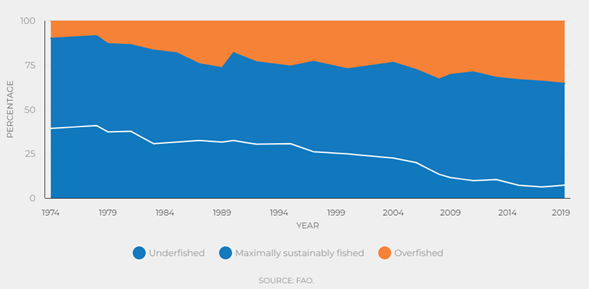
Figure 1 World trend of the marine exploited stocks.1
According to official data on fishing exploitation by region, 77% of the national catch is extracted from the Gulf of California, equivalent to 51% of the value of fishing in Mexico. These data emphasize the importance of this region of the country, which confirms the qualification that Jack Cousteau assigned to the Gulf of California as the world’s aquarium.
Fishing activity is essentially economic and for this reason, it is very important to take into account the need to be sustainable, since many people depend on it because it constitutes an important source of jobs and food for a growing human population, in addition to being an important source of foreign currency, as ocurrs with the shrimp fishery. Fishing resources must remain renewable, and this will be fully met to the extent that society exploits them sustainably.
To meet these expectations, all the stages of a process must ensure to achieve this goal be met, since the counterpart of the exploitation with research aimed at the evaluation of each resource is met too, which serves as a basis for the application of regulatory measures derived from evaluations. Science must be capable of evaluating exploitable resources, issuing the results of the evaluations, and the official bodies in charge of their administration, to apply the most convenient regulations to guarantee their sustainable use. Several management options can be distinguished, which would be oriented towards achieving the greatest biomass production, achieving the greatest profits, or achieving the greatest economic benefits per fisherman. However, it is considered that all measures applied for the administration of any fishery must be done with the consensus of the stockholders in charge of exploiting the resource. This is in the context that said stockholders are the main beneficiaries and they are the ones on whom the conservation of resources would depend.
Measures aimed at the rational exploitation of a fishery can be of various types, restrictions on fishing in certain areas, temporary restrictions or closures to protect the breeding season, prohibition of the capture of juveniles or pregnant females, catch quotas, regulations on the number of fishing days, prohibition of certain types of fishing gear, regulation on the number, size and light of meshes, etc. The most obvious and immediately applicable regulatory measures are aimed at the application of measures that regulate access to the resource; that is, determination of the number of fishing days and definition of a minimum legal size for its catch. The application of these two provisions is one of the most useful, of immediate use and has visible effects at the end of the fishing season. Furthermore, the capture of juvenile fish and the application of excessive fishing effort constitute the most common problem in fisheries worldwide and that has contributed the most to the overexploitation and depletion of many fishery resources, because the worst negative effects it has on the resources consist, first of all, in a reduction in the capacity of renewal of the populations by significantly reducing their capacity to regenerate its biomass through the reproductive process. Additionally, the application of excessive effort determines a reduction in the number of reproducers and with it a reduction in the capacity of renewal of stocks, which can lead to depletion and eventually their extinction. Due to all these characteristics, it is said that it is practically impossible to extinguish a fishing population as a result of overfishing. This statement has a lot of truth, since fishing is a predominantly economic activity, when a resource becomes very scarce due to excessive fishing effort, as it is unaffordable to continue exploiting it, fishing ceases and is abandoned. Occasionally the resource might recover, but this is not a rule.
Traditional methods for evaluating fishing stocks were published in the classic book by Beverton and Holt,2 this book has become the bible of fisheries biologists and is a mandatory reference for those of us dedicated to the task of evaluating fisheries. After this invaluable source of information, other books have been published on the subject, but in general they only add another perspective to the one mentioned above; the main ones are a few: Gulland,3 Sparre and Venema,4 Hilborn and Walters,5 etc., whose consultation can be very useful since Beverton and Holt’s book is not easily accessible at present. After the aforementioned books, new methods of fisheries evaluation have been developed, based on the use of simulation models, the scope of which makes it possible to give traditional methods new approaches and greater versatility, as is the case of the evaluations that constitute the focus of this paper.
With the use of the methods applied to the sardine and shrimp fisheries of the Gulf of California, the absolute size of the population and the catch rate were evaluated, with the help of data on fishing effort and sampling in the areas of landing of the captured product. It is pertinent to note that, in the initial stages of the process of evaluating the fishery, sampling of individual populations allows us to know the size composition, with which it is essential to determine the average individual growth rate of the exploited population. Ideally, this process should be carried out permanently, since the age structure and size of said population are being modified continuously by natural processes and fishing.
When evaluating an exploited stock, it is possible to determine how many individuals of each age are caugth compared to the total population, that is, the catch rate, as well as this information allows us to know how many of them are juveniles. In many cases, the catch consists only of juvenile animals and in these cases the population is compromised, since fishing does not allow a sufficient number of fish to reach the age of maturity and with this situation there is a risk of extinction due to mortality caused by overfishing.
The sardine fishery is a relevant economic activity in the country. This activity represents around 30% of Mexico’s total catches with around 300 thousand tons per year. It has the most important fleet and industrial plant of its kind in the country. It is the most abundant, although not the most valuable. It generates many jobs, mainly indirect. It is used mainly to produce balanced foods for domestic animals and a small portion for human consumption. Its biomass depends greatly on climate variability and that means that in some years it is overexploited with the same fishing pressure as in years when its biomass is high. Currently, it is exploited very close to its maximum production level, but it is not threatened by fishing pressure. This fishery is made up of seven species, of which the Monterrey sardine is by far the most abundant. Fishing intensity remained relatively stable until 1997, catching for about 5,000 days per season, increasing to 15,000 and 28,700 days, respectively during 2008 and 2009. Fishing trips have steadily increased from 40 to 80 trips per boat over the years. Profits follow the same trend as the catch, ranging between one million and twelve million USD in most seasons, with four peaks. In 12 years, the fishery produced more than 15 times the cost of fishing.
The evaluation of this fishery since the beginning of this activity in 1969, indicates that the catch has been very variable with ups and downs, but within this variability, the proportion of the Monterrey sardine far exceeds that of the other six species, which appear as incidental catch (Figure 2). The production trend indicates an increase that reaches more than 600,000 t in 2008.
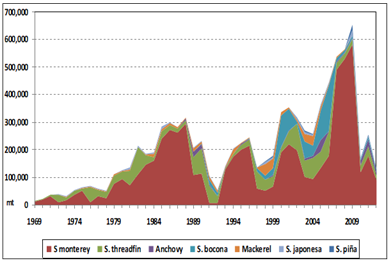
Figure 2 Catch of sardine and incidental species in the Gulf of California since the beginning of the fishery.
The assessment of the Monterrey sardine stock shows that the oscillating catch also corresponds to that of the biomass of this population which are equally variable (Figure 3); here, its biomass values show a notable increase since 1973, reaching up to 5,000,000 t in 1992. After that year, the catch is close to 2,000,000 t.
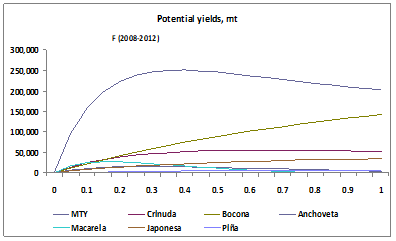
Figure 3 Potential yield of the sardine and the incidental (t), as a function of the fishing mortality (horizontal scale).
When examining the population trend, it is noticeable to perceive that the potential catch of the species can reach almost 250,000 t with a fishing mortality which is proportional to the intensity of fishing, of F = 0.25. The production of the other species is secondary. The current catch is located very close to the maximum that could potentially be obtained; it is at a level of F = 0.24, while the maximum potential would be obtained at F = 0.35.
When economic returns of the fishery are examined, which are obtained by transforming the catch data into its equivalent value, less the cost of fishing operations, the resulting picture changes a little than in the former case and it is perceived that the economic return of mackerel is evident, although not with the importance of the Monterrey sardine, whose maximum potential would be a little below from the so-called Maximum Economic Yield, which is higher than 90 million dollars (Figure 4). It is important to note that the value of the catch of incidental stocks is minimal and shows often negative values.
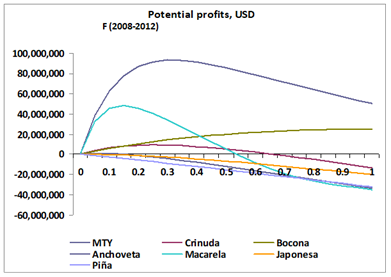
Figure 4 Maximum potential economic yield of sardine and incidental stocks (in USD), as a function of fishing mortality (horizontal scale).
Among the recommendations that are considered pertinent to make, is that a) The fleet should not have more than 50 fishing boats; b) The number of fishing days must not exceed 6,000 days per season; and c) When new vessels are intended to be recruited to the fishery, their fishing capacity must be not higher than the current fleet it replaces.
Shrimp from the Gulf of California produces about 80 thousand tons (including wild and farmed). It is the most valuable fishery in the country, representing almost 40% of the value of the country’s fishing production, with more than US$132 million per season and generating more than 300 thousand jobs. Although it is exploited to its maximum capacity and there are years in which it is overexploited, it can be stated that this resource is far from being at risk of depletion due to overexploitation. This fishery is based on the capture of four main species of shrimp, which in order of importance are: brown shrimp, blue shrimp, white shrimp and red shrimp.
As a departing point, it is assumed that this activity on the offshore seas is overcapitalized and that the resource is overexploited. The process of evaluating and fitting the simulation model to the data is presented in Figs. 5a and 5b, which correspond to the cases of brown shrimp and blue shrimp, respectively. In the first of them, the fishing mortality values correspond to blue bars on the scales on the right side in both cases. The trends in the exploitation rate (E) are indicated with dotted lines. Two horizontal lines describe the values of fishing mortality and the exploitation rate, which are the thresholds of overexploitation and which in a healthy fishery should not be exceeded. In the case of brown shrimp (Figure 5a), it is observed that the catch exceeded the limit during the years 2013 and 2014; in blue shrimp (Figure 5b), there was overfishing during the years 2011 and 2013. It is interpreted that, in both cases, these yields exceeding the acceptable limit are not the result of a trend, but of a combined effect of scarcity of recruits, some change in the climate and, an increase in fishing pressure.
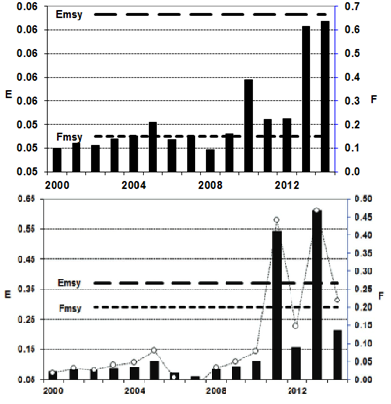
Figure 5a (above), 5b (lower side) Trends of the Fishing mortality F and the exploitation rate (E) of the Brown shrimp (upper figure), and the Blue shrimp (lower figure) caught in the Gulf of California for the years 2000 -2014.
As indicators of management of this fishery, Figure 6 is shown, which displays the options to manage this fishery; based on the minimum age of the first catch and the intensity of the fishing effort.

Figure 6 Options proposed to manage the Gulf of California shrimp fishery, according to the age of first capture, in months, as well as the intensity of exploitation or fishing mortality (F annual). The estimated values for the 2014 fishing season were used as a reference. FMSY = Fishing mortality at the level of maximum sustainable yield; FMEY = Fishing mortality at the level of maximum sustainable economic yield; FMEY/pesc = Fishing mortality at the level of the maximum sustainable economic yield per fisherman.
The response of the shrimp populations that make up the fishery has a differential pattern, which depends on the dynamics of each one and is a function of their adaptation to the environment and the fishing gear. In this way, each one has a potential response to fishing pressure, as seen in Figure 7a, which shows the potential production capacity of the resource depending on the intensity of fishing, expressed here as days of fishing, at an age of first capture of four months. It is perceived that the dynamics of the blue and white shrimp populations make the blue shrimp more productive, but less so the white shrimp, and the fishing intensity slightly exceeds the optimal capture level in both cases. The brown shrimp is the most productive of the three, but its catch trend indicates that it is slightly underexploited. The line that describes the global catch indicates that the total fishing mortality is very close to the optimal level, with a production of around 25 thousand tons per season.
In contrast to the previous case, the response of the population was simulated with an age of first capture of five months; here, in contrast to the previous case, the response of the population was simulated with an age of first capture of five months, where it is remarkable to perceive that (Figure 7b), by leaving the shrimp unexploited for one more month of age, although there was some natural mortality, its biomass was compensated by the presence of larger shrimp, which would allow a potential catch of about 35 thousand tons with the same fishing effort as in the previous case, but with 10 thousand tons more than in the former case.
This presentation, is intended to emphasize the need to evaluate fisheries with a quantitative approach, since it is considered the only option to make precise recommendations aimed at the management and conservation of fisheries resources. We live in a world overwhelmed by human overpopulation in a society that is increasingly developed and every day more capable of exploiting and modifying the natural environment more profoundly. With each passing day, the news abound in recounting daily problems, by violence, the excessive use of natural resources, and the increase in the number of wastes polluting natural waters and destroying the environment. Humanity is on the threshold of irreversible change due to the risk of crossing the threshold of global temperature, while efforts to stop the contribution to the carbon footprint are insufficient.6
These are just some of the problems that afflict human beings, and this is why it is urgent to increase capacity building at human resources at all levels of education to confront the environmental crisis. The informed management of fishery resources is just one example of how to address the problem of this environmental crisis that humanity should control, before it turns against us and compromises our future.
The methodological description of the digital tool on which this brief essay was based was published in the papers by Chávez,7 and Chávez-Ortiz.8 The abbreviated description of the sardine and shrimp fisheries was made based on the papers by García-Sandoval and Chávez,9 and Ramírez-Villalobos and Chávez.10 This document was generated as a result of an online talk, sponsored by the Southern Baja California Council of Humanities, Science and Technology at La Paz, Baja California South, on April 30, 2024. The autor aknowledges the editorial job done by the Editorial & Review Analyist of the MedCrave Group.
The author declares that there are no conflicts of interest.

©2024 Chávez. This is an open access article distributed under the terms of the, which permits unrestricted use, distribution, and build upon your work non-commercially.